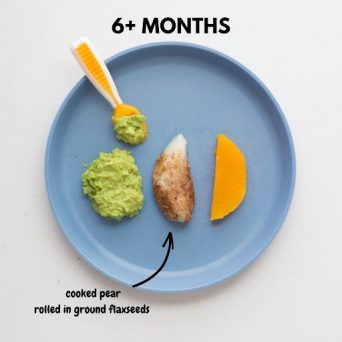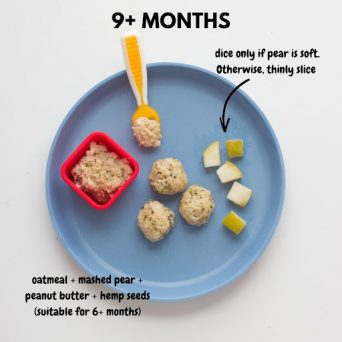One of the most exciting milestones for new parents is the introduction of solid foods – but it can also be one of the most confusing. When to start? What foods to choose, and how to serve them? There are generally three styles of food introduction when starting solids (typically around 4-6 months, when baby is strong enough to sit unassisted): purees (spoon feeding), baby led weaning (also known as self-feeding), or a combination of both. Whichever method works for your family, the most important thing is to provide nutrient-rich foods for your baby to safely experiment with, and luckily pears are a great addition to either style.
As a naturally sweet, nutrient-dense and incredibly versatile food, pears are a fundamental first food for babies. They can be pureed (with or without other ingredients) for the earliest introduction, served as ripe, soft slices during baby led weaning or diced for older babies practicing their pincer grasp. Read on for the benefits of introducing pears as one of baby’s first foods, how to safely prepare them and more.
Top 3 Benefits of Pears as a First Food
- Fiber: Pears are a fiber powerhouse, ranking higher than almost every other fruit with 6 grams in just one pear. As babies start eating solids, their digestive systems must adapt to a range of new foods and constipation is a common problem, which pears can help alleviate thanks to their fiber content. (Bonus! Since constipation can be an issue during pregnancy and postpartum, pears are an ideal food for moms-to-be and new moms to enjoy as well.)
- Iron Absorption: Iron is essential for baby’s brain, body, and immune system development. Babies are born with iron reserves that wane by about 6 months of age, so it’s important to serve iron-rich foods as soon as solids are introduced. There are two types of iron – heme (found in animal products) and nonheme (found in plant foods, like beans). While heme iron is absorbed more readily compared to nonheme iron, many young babies don’t take to meat right away, and nonheme iron found in foods like beans or tofu is not as readily absorbed. However, combining plant-based sources of iron with a source of vitamin C, like pears, enhances iron absorption.1
- A Sweet You Should Eat: Did you know babies are exposed to sweet flavors from birth (since breastmilk contains 2g sugar per ounce, and most formulas contain at least that)?2 The USDA advises added sugars should be avoided before 2 years,3 which makes pears a great addition to vegetable, grain or even meat purees to make new flavors more palatable for little ones. Not to mention of course, pears served on their own are sure to result in big smiles and full bellies.
How to Safely Offer Pear to Babies
To check if a pear is ripe, check the neck: Apply gentle pressure to the neck of the pear with your thumb. If the area near the stem yields to pressure, it’s ripe and ready to eat. For a pear to be safe for serving to babies raw, the skin and flesh should be soft to the point you can mash it between your fingers – typically a little more ripe than what many adults would prefer. If a pear is firm, you can boil, steam or saute to soften.
6-9 months:
- Purees: Blend raw or cooked pear with a little breastmilk or formula to desired consistency. A thick puree can be spoon-fed or offered on a self-feeding spoon, or a thinner consistency can be offered in an open or straw cup for baby to practice her drinking skills. Parents can also use pear in any number of smoothie recipes, for a delicious and healthy snack to share (just make sure to avoid honey in any smoothies for babies younger than 12 months).
- Wedges/Spears: For baby led weaning, use either a super ripe or cooked pear and cut into large spears roughly the size and shape of a finger. Try rolling in hemp seeds, ground flaxseeds, nuts, finely shredded coconut, etc. to keep it from slipping out of baby’s hands.
- Grate or Mash: Raw pear can be grated or mashed and added to oatmeal, yogurt, hummus etc.

Image Credit: Min Kwon of MJ & Hungryman Blog
9-12 months:
- In addition to the suggestions above, you can thinly slice raw pears.
- If the pear is ripe and the skin and flesh are super soft, you can dice into bite-sized pieces.
A note on skin: As with many fruits and vegetables, most of the nutrients in pears are found in the skin. It is safe to leave on if the skin and flesh are really ripe and soft. Your baby may spit it out, but this is great texture exposure nonetheless! For firmer pears, wait until baby is at least 12 months old before leaving the skin on.

Image Credit: Min Kwon of MJ & Hungryman Blog
Pear Varieties
There are 10 varieties of USA Pears, each with its own distinctive color, flavor and texture. With overlapping seasons of availability, USA Pears are in season nearly year-round. Some pear varieties, such as Bartlett, Red Bartlett, and Starkrimson, get softer and sweeter when ripe, making them ideal for serving to babies raw. Varieties like Red or Green Anjou, Bosc, Comice, or Concorde, don’t ripen to be quite as soft, making them better for cooking, grating or blending into purees.
For Babies and Beyond
According to USDA MyPlate recommendations, toddlers should eat ½ to 1 serving of fruit per day and children 2-4 years should eat 1 to 1½ servings. As children get older, their fruit needs increase to up to 2-3 servings per day. A medium pear is equal to one serving of fruit, and all the health benefits for baby continue through childhood and into adulthood, including during pregnancy and postpartum. The vitamin C that helps babies with iron absorption is vital for immunity at all life stages. The fiber that helps little ones with constipation helps ensure bowel regularity and may even reduce the risk of colon cancer in adults. The list goes on, with emerging research studying the connection between pear consumption and weight and diabetes management, heart health, brain health and more.
Learn more about pear nutrition at any age, or explore recipes here.